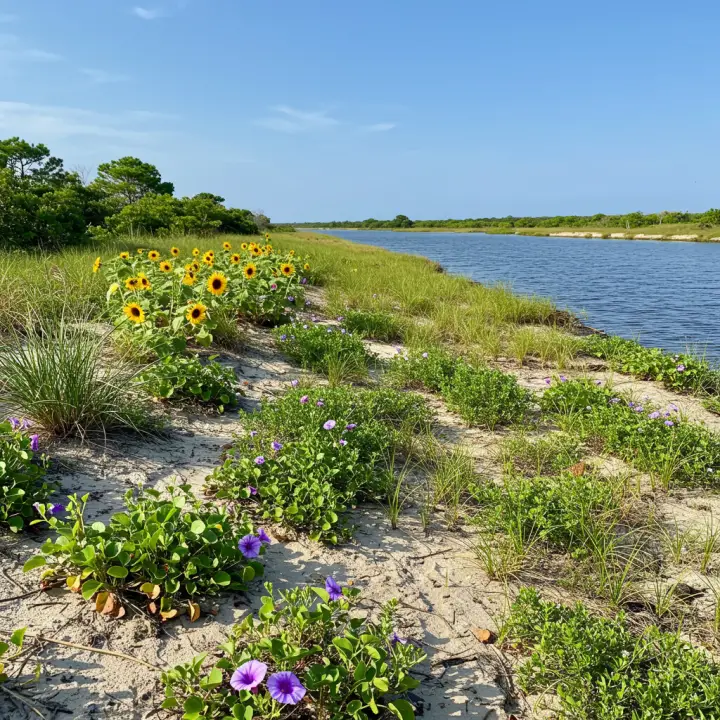This guide explores the best plants for erosion control in Florida, considering the state’s unique climate and soil conditions. We’ll cover various plant types, from groundcovers and shrubs to trees, and provide tips for successful planting and maintenance.
Erosion is a significant concern in Florida, particularly in coastal areas and regions with heavy rainfall. The loss of topsoil can lead to structural damage, water pollution, and habitat destruction. Fortunately, strategically planting vegetation offers a natural and effective solution to combat erosion. This blog post will delve into the best plant choices for erosion control in Florida, helping you choose the right species for your specific needs and location.

Groundcovers for Erosion Control
Groundcovers are essential for stabilizing soil and preventing erosion, especially on slopes and banks. They form a dense mat that binds the soil together.
Native Florida Groundcovers
- Sunshine Mimosa (Mimosa strigillosa): This low-growing, spreading perennial thrives in full sun and tolerates drought conditions. It’s ideal for stabilizing sandy soils.
- Frogfruit (Phyla nodiflora): A vigorous groundcover, Frogfruit forms a dense mat that effectively controls erosion while also attracting pollinators. It’s tolerant of foot traffic and drought.
- Beach Sunflower (Helianthus debilis): A drought-tolerant and salt-tolerant option, Beach Sunflower is perfect for coastal areas prone to erosion. Its bright yellow flowers add a splash of color to the landscape.
Other Effective Groundcovers
- Asiatic Jasmine (Trachelospermum asiaticum): This fast-growing vine is a popular choice for quickly covering large areas. It’s tolerant of various soil conditions and partial shade.
- Liriope (Liriope muscari): Liriope is a low-maintenance groundcover that provides excellent erosion control and tolerates shade.
Shrubs for Erosion Control
Shrubs provide a larger barrier against erosion than groundcovers and are ideal for stabilizing larger areas or slopes.
Native Florida Shrubs
- Buttonbush (Cephalanthus occidentalis): This attractive shrub thrives in wet areas and helps stabilize shorelines and stream banks. It also provides habitat for wildlife.
- Wax Myrtle (Myrica cerifera): A fast-growing shrub, Wax Myrtle is adaptable to various soil conditions and helps prevent erosion on slopes.
- Seagrape (Coccoloba uvifera): Perfect for coastal areas, Seagrape is highly salt-tolerant and provides excellent wind and erosion protection.
Other Effective Shrubs
- Shore Juniper (Juniperus conferta): A low-spreading shrub, Shore Juniper forms a dense mat that effectively controls erosion on slopes and sandy soils.
Trees for Erosion Control
Trees offer the most comprehensive erosion control, particularly for stabilizing large areas and preventing landslides.
Native Florida Trees
- Mangroves (Rhizophora mangle, Avicennia germinans, Laguncularia racemosa): These vital coastal trees protect shorelines from erosion and storm surge. They create crucial habitats for marine life.
- Live Oak (Quercus virginiana): A majestic and long-lived tree, the Live Oak provides excellent erosion control with its extensive root system.
- Bald Cypress (Taxodium distichum): This adaptable tree thrives in wet areas and helps stabilize riverbanks and swampy areas.
Other Effective Trees
- Southern Magnolia (Magnolia grandiflora): With its large, spreading root system, Southern Magnolia provides significant erosion control and creates a beautiful focal point in the landscape.
Planting and Maintenance Tips for Erosion Control
- Proper Site Preparation: Before planting, amend the soil with organic matter to improve drainage and water retention.
- Plant Spacing: Follow recommended spacing guidelines for each plant species to ensure optimal growth and erosion control.
- Watering: Water newly planted vegetation regularly, especially during dry periods, to establish a strong root system.
- Mulching: Applying mulch around plants helps retain moisture, suppress weeds, and further protect against erosion.
- Regular Maintenance: Prune shrubs and trees as needed to maintain their shape and prevent overgrowth.
FAQs: Best Plants for Erosion Control in Florida
Q: What are the fastest-growing plants for erosion control in Florida?
A: Some of the fastest-growing options include Asiatic Jasmine, Wax Myrtle, and Beach Sunflower.
Q: What are the best plants for erosion control on a steep slope?
A: Consider groundcovers like Sunshine Mimosa and Frogfruit, or shrubs like Shore Juniper and Wax Myrtle.
Q: What are the best salt-tolerant plants for coastal erosion control?
A: Mangroves, Seagrape, and Beach Sunflower are excellent choices for coastal areas.
Q: What is the best time to plant for erosion control in Florida?
A: Spring and fall are generally the best times to plant in Florida, as the milder temperatures are ideal for root establishment.
Q: How can I determine the best plants for my specific location?
A: Contact your local UF/IFAS Extension office for personalized recommendations based on your soil type, climate, and specific needs.
Conclusion: Choosing the Right Plants
Choosing the right plants for erosion control in Florida requires careful consideration of your specific location, soil conditions, and the severity of the erosion. By selecting a combination of groundcovers, shrubs, and trees adapted to Florida’s climate, you can effectively combat erosion, enhance your landscape, and protect your property. Remember to follow proper planting and maintenance guidelines for optimal results. By taking proactive steps to control erosion, you can contribute to the preservation of Florida’s beautiful and fragile environment.

